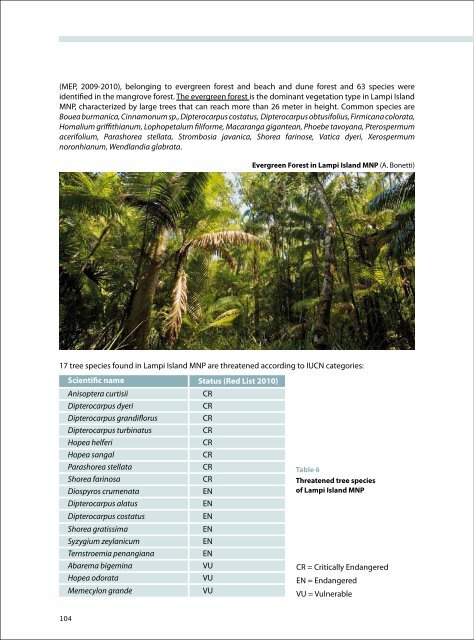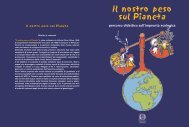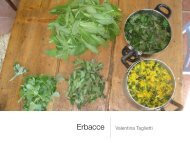Myanmar Protected Areas: Context, Current Status ... - Istituto Oikos
Myanmar Protected Areas: Context, Current Status ... - Istituto Oikos
Myanmar Protected Areas: Context, Current Status ... - Istituto Oikos
Create successful ePaper yourself
Turn your PDF publications into a flip-book with our unique Google optimized e-Paper software.
(MEP, 2009-2010), belonging to evergreen forest and beach and dune forest and 63 species were<br />
identified in the mangrove forest. The evergreen forest is the dominant vegetation type in Lampi Island<br />
MNP, characterized by large trees that can reach more than 26 meter in height. Common species are<br />
Bouea burmanica, Cinnamonum sp., Dipterocarpus costatus, Dipterocarpus obtusifolius, Firmicana colorata,<br />
Homalium griffithianum, Lophopetalum filiforme, Macaranga gigantean, Phoebe tavoyana, Pterospermum<br />
acerifolium, Parashorea stellata, Strombosia javanica, Shorea farinose, Vatica dyeri, Xerospermum<br />
noronhianum, Wendlandia glabrata.<br />
Evergreen Forest in Lampi Island MNP (A. Bonetti)<br />
17 tree species found in Lampi Island MNP are threatened according to IUCN categories:<br />
Scientific name <strong>Status</strong> (Red List 2010)<br />
Anisoptera curtisii CR<br />
Dipterocarpus dyeri CR<br />
Dipterocarpus grandiflorus CR<br />
Dipterocarpus turbinatus CR<br />
Hopea helferi CR<br />
Hopea sangal CR<br />
Parashorea stellata CR<br />
Shorea farinosa CR<br />
Diospyros crumenata EN<br />
Dipterocarpus alatus EN<br />
Dipterocarpus costatus EN<br />
Shorea gratissima EN<br />
Syzygium zeylanicum EN<br />
Ternstroemia penangiana EN<br />
Abarema bigemina VU<br />
Hopea odorata VU<br />
Memecylon grande VU<br />
Table 6<br />
Threatened tree species<br />
of Lampi Island MNP<br />
CR = Critically Endangered<br />
EN = Endangered<br />
VU = Vulnerable<br />
Scientific name <strong>Status</strong> (Red List 2010)<br />
Sonneratia griffithii CR<br />
Heritiera fomes EN<br />
Aegialitis rotundifolia NT<br />
Brownlowia tersa NT<br />
In-depth Study of Lampi Island Marine National Park<br />
The beach and dune forest is found along narrow strips on beaches and dunes along the coast in<br />
the locality of Baik Aw or Tourist River, Balaik Aw and Bawin Aw. It supports pure stands of Casuarina<br />
equisetifolia and species of Dillenia and Calophyllum.<br />
Beach and dune forest in Lampi Island MNP (L. Beffasti)<br />
The mangrove forest, although minor in terms of extension, is in almost intact conditions with high<br />
ecological value. The pristine areas are located at Labi Chaung, Khe Chaung, Mi Gyaung Aw and Thit<br />
Wa Aw on the west coast and in Bulet Aw on the east coast of Lampi Island. The mangrove survey<br />
conducted in Lampi Island MNP area in February-April 2010 recorded a total of 63 species belonging<br />
to 31 families, comprising both woody species (40 species) and mangrove associates (23 species of<br />
shrubs and climbers), which is a reflection of the fact that the Myeik Archipelago is located within<br />
the Indo-Malayan biogeographic region which has the highest diversity of mangroves in the world.<br />
Two community types of mangrove forests are found in Lampi Island MNP, the Rhizophora apiculata<br />
community and the Bruguiera cylindrica community, well correlated to the level of tidal zone and the<br />
sediment types. Dominant species of mangroves are Rhizophora apiculata (Byu-che-dauk-apo) and<br />
Rhizophora mucronata (Byu-che-dauk-ama), species that in the seashore where salinity is very high are<br />
the only ones present. One species Pemphis acidula recorded during the mangrove study is of particular<br />
interest since it is known to occur in East Africa but absent from South India to Sumatra, and it reappears<br />
in East Malaysia. Its presence on Lampi and adjacent islands fills a critical gap in the available information<br />
about the distribution of this species. On the other hand, some mangrove species such as Sonneratia<br />
apuitala (Kan-pa-la), Sonneratia cassiolaris (La-mu), Xylocarpus mulocensis (Kya-na) and Amoora cucullata<br />
(Pan-tha-ka), present in other mangrove areas of <strong>Myanmar</strong>, are not found in Lampi area, due to high<br />
salinity (3.5% - 3.8%) and soil types (loamy sand and sandy loam soils are common).<br />
Table 7<br />
Threatened and near threatened<br />
mangrove species of Lampi Island MNP<br />
CR = Critically Endangered<br />
EN = Endangered<br />
NT = Near Threatened<br />
104 105






